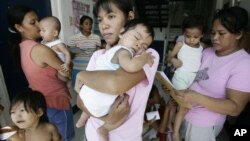GENEVA —
The World Health Organization and U.N. Children's Fund are unveiling a new strategy to end preventable child deaths from pneumonia and diarrhea by 2025. The agencies say this new plan of action potentially could save the lives of up to two million young children each year.
Pneumonia and diarrhea are two leading killers of young children. Together, they account for nearly one-third of all the deaths of children under five years old in developing countries. Nearly 90 percent of the two million annual child deaths from these two diseases occur in sub-Saharan Africa and South Asia.
Health agencies say children are dying from these preventable diseases because effective interventions are not reaching them or are not being provided equitably across all communities.
Elizabeth Mason, director of the World Health Organization's Department of Maternal, Newborn, Child and Adolescent Health, says pneumonia and diarrhea are currently treated separately. She says evidence from countries such as Bangladesh, Ethiopia, and Tanzania show it makes good health and economic sense to tackle these diseases together.
She says many factors contribute to pneumonia or diarrhea, so no single intervention can effectively prevent, treat or control these two conditions. She says the new approach involves putting the known interventions into one comprehensive, integrated package.
“Current interventions, such as exclusive breast-feeding, good under-five good nutrition for children, hand washing, safe drinking water, improved cook stoves, environmental pollution, zinc, oral rehydration solution, antibiotics, such as amoxicillin, vitamin A, and vaccination need correct and consistent and sustained use,” said Mason.
Vaccines against pneumonia and diarrhea are not affordable in many developing countries. The GAVI Alliance, a public-private partnership, provides funding that increases access to immunization in developing countries.
To date, GAVI has helped 24 poor countries immunize 13 million children with pneumococcal vaccines to prevent pneumonia and 13 countries with rotavirus vaccines to immunize five million children against diarrhea.
GAVI welcomes the WHO/UNICEF integrated global action plan and says it hopes to accelerate affordable access to these life-saving vaccines by developing countries.
WHO’s Mason believes the targets set by the new integrated approach for ending preventable child deaths from pneumonia and diarrhea by 2025 are achievable.
“In this respect, we are saying that pneumonia in children under five, there should be no fewer than three per thousand deaths and for diarrhea fewer than one per thousand deaths, which is totally less than four per thousand deaths from these two diseases," explained Mason. "And, we believe that in a further 10 years, we should be able to have no deaths from diarrhea and pneumonia.”
Dr. Mason says it will cost just over $6 billion to implement the strategy over a 10-year period. She says that comes to just about $600 million a year. She notes the return from this relatively small amount of money is huge in terms of millions of children’s lives saved.
Pneumonia and diarrhea are two leading killers of young children. Together, they account for nearly one-third of all the deaths of children under five years old in developing countries. Nearly 90 percent of the two million annual child deaths from these two diseases occur in sub-Saharan Africa and South Asia.
Health agencies say children are dying from these preventable diseases because effective interventions are not reaching them or are not being provided equitably across all communities.
Elizabeth Mason, director of the World Health Organization's Department of Maternal, Newborn, Child and Adolescent Health, says pneumonia and diarrhea are currently treated separately. She says evidence from countries such as Bangladesh, Ethiopia, and Tanzania show it makes good health and economic sense to tackle these diseases together.
She says many factors contribute to pneumonia or diarrhea, so no single intervention can effectively prevent, treat or control these two conditions. She says the new approach involves putting the known interventions into one comprehensive, integrated package.
“Current interventions, such as exclusive breast-feeding, good under-five good nutrition for children, hand washing, safe drinking water, improved cook stoves, environmental pollution, zinc, oral rehydration solution, antibiotics, such as amoxicillin, vitamin A, and vaccination need correct and consistent and sustained use,” said Mason.
Vaccines against pneumonia and diarrhea are not affordable in many developing countries. The GAVI Alliance, a public-private partnership, provides funding that increases access to immunization in developing countries.
To date, GAVI has helped 24 poor countries immunize 13 million children with pneumococcal vaccines to prevent pneumonia and 13 countries with rotavirus vaccines to immunize five million children against diarrhea.
GAVI welcomes the WHO/UNICEF integrated global action plan and says it hopes to accelerate affordable access to these life-saving vaccines by developing countries.
WHO’s Mason believes the targets set by the new integrated approach for ending preventable child deaths from pneumonia and diarrhea by 2025 are achievable.
“In this respect, we are saying that pneumonia in children under five, there should be no fewer than three per thousand deaths and for diarrhea fewer than one per thousand deaths, which is totally less than four per thousand deaths from these two diseases," explained Mason. "And, we believe that in a further 10 years, we should be able to have no deaths from diarrhea and pneumonia.”
Dr. Mason says it will cost just over $6 billion to implement the strategy over a 10-year period. She says that comes to just about $600 million a year. She notes the return from this relatively small amount of money is huge in terms of millions of children’s lives saved.










